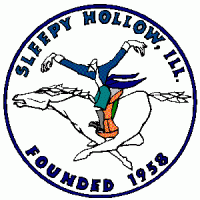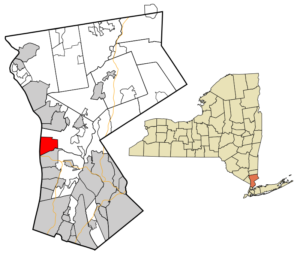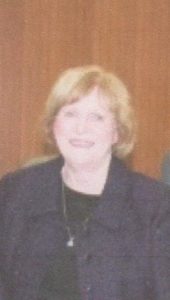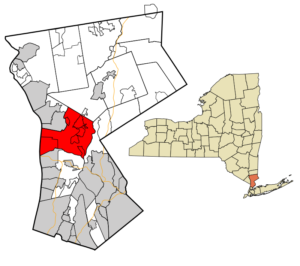
PARTY HEARTY: Paula A. McCarthy Tompkins Is Out Having A Good Time At This Years WMOA Dinner, As Freedom Of Information Requests For Public Documents Go Unanswered In Here Office
1. Freedom Of Information Compliance And Knowledge Ratings:

Sleepy Hollow Village Manager Anthony Giaccio
Has Failed To Bring Accountability To The Clerk’s Office.
Village of Sleepy Hollow Clerk Paula A. McCarthy Tompkins is the only clerk in Westchester County that has failed to respond to any of the test Freedom of Information requests for public documents, despite follow ups with the village manager, village mayor and elected officials.
The Village of Sleepy Hollow (Village) is located in the Town of Mount Pleasant in Westchester County. The Village covers approximately fi ve square miles and has approximately 9,870 residents.
Sleepy Hollow Mayor Ken Wray was elected Village Trustee in 2007 and elected Village Mayor in 2009. He was re-elected in 2011 and 2013. In 2015, Ken Wray was re-elected again as Village Mayor for a 4th term

Ken Wray With Village Trustees
The Village is governed by an elected Board of Trustees (Board) which is composed of a Mayor and six Trustees. The Board has the power to levy taxes on real property located in the Village and to issue debt. The Village’s total expenditures for the general fund for 2010 were $12 million and the 2011 adopted general fund budget was $13 million. The police department employs approximately 25 full time offi cers and is supervised by the Chief, who reports to the Board.
Board Members

Sleepy Hollow Administrator Anthony Giaccio
The Village Administrator and appointed department heads are responsible for the day-to-day management of the Village’s activities, including overseeing the Finance Department and supervising staff that maintain the financial accounting records and process cash receipts. The Treasurer is the custodian of Village funds and is responsible for receiving and recording Village moneys, reconciling the accounting records to bank statements, providing annual financial reports to the Office of the State Comptroller and the Board, and for providing monthly financial reports to the Board.

There seems to be a lot of disfuntion in the village of Sleepy Hollow, the State Comptroller recently did an audit and found
The Board and other Village officials are responsible for developing procedures and/or processes to ensure that Village resources, including cash, are safeguarded. These policies and procedures provide assurance that all cash is accounted for, properly documented, recorded, and physically safeguarded until deposited. The Village Administrator is responsible for overseeing the Finance Department and supervising staff that maintain the fi nancial accounting records and process cash receipts. The Treasurer is the custodian of Village funds and is responsible for receiving and recording Village moneys.
Policies and Procedures
It is important that the Board adopt policies and Village offi cials establish written procedures for cash receipts that address the assignment of authority, approval of transactions, protection of assets, periodic reconciliations and analytical reviews. It is important that Village offi cials clearly communicate these policies and procedures to all individuals involved with cash transactions. Clearly defi ned and communicated authorizations help establish a substantial framework of internal control.
Neither the Board nor Village offi cials developed processes to safeguard and account for cash receipts. Finance employees did not always issue pre-numbered duplicate receipts for all cash collections. We found three instances where payments totaling $1,410 were posted as cash but no documentation was provided to us to show that cash receipts were deposited into the Village’s bank accounts. In addition, we found four cash payments totaling $1,558 that were deposited into the Village’s bank account but cash receipts were never posted into the Village’s fi nancial accounting system, and two receipts that were posted 13 to 29 business days after they were deposited. Furthermore, the safe in the fi nance department was left open during the day giving employees from fi nance, the Village Clerk and her deputy unlimited access to un-deposited and petty cash. Finally, there were no inventory controls for parking permits which have a value of $210 or $150 each.
It is important that the Board adopt policies and Village offi cials establish written procedures for cash receipts that address the assignment of authority, approval of transactions, protection of assets, periodic reconciliations and analytical reviews. It is important that Village offi cials clearly communicate these policies and procedures to all individuals involved with cash transactions. Clearly defi ned and communicated authorizations help establish a substantial framework of internal control. We found that the Board did not adopt policies and Village offi cials did not develop and clearly communicate policies and procedures to individuals involved with cash transactions, such as individuals in the Recreation and Parks Department (Parks). Parks collects cash for various programs (afterschool program, meals on wheels, specialty camps, and park rental); however, no formalized process was communicated to the Parks Supervisor. When we reviewed the procedures for cash collections, we found that although the Park’sSupervisor prepared and issued receipts for cash collected at the various sites, it was not always at the time of receiving the cash. In certain instances, the receipts were prepared after the fact, based on the bills and checks received.
When the Parks Supervisor turned over the cash receipts to the Finance Department, she also turned over the duplicate cash receipt book (one of three used by the department, concurrently) as documentation of the receipts. However, there was no formalized process governing how often receipts were required to be turned over to the Finance Department. Checks were held by Parks for one to 15 days from receipt. For example, while we were on site documenting the procedures at Parks, we found the cash box had $3,000 in cash and checks, and that the corresponding receipts were dated from one to 15 days prior to our visit.
The absence of written policies and procedures inhibits the Board’s ability to ensure that Village assets are properly safeguarded, accounting transactions are recorded and reported properly, and that work performed is adequately monitored and routinely reviewed. This increases the risk that Village funds could be lost, stolen or misused.
Recording, Depositing and Posting of Receipts
Village offi cials must ensure that employees issue pre-numbered duplicate receipts for all cash collections and maintain a daily record of all cash receipts that includes the receipt numbers, with the dates and amounts collected. Employees should total the receipts each day and compare the amounts to the duplicate deposit ticket prepared for that day’s receipts. All receipts should be deposited in a timely manner to help prevent loss or theft. Someone other than those collecting the cash and reconciling to the amounts deposited at the bank should review the cash receipt records to verify that they are timely, accurate and complete. In addition, the prompt posting of deposits in the accounting system helps to ensure that the fi nancial records are current and provides assurance that Village moneys are properly accounted for. Delays in the deposit and/or posting of cash payments increase the risk of error or misuse and may misrepresent the actual cash fl ow. Further, an accurate and up-to-date record of all deposits is necessary for the proper and timely reconciliation of bank statements. Restricting access to the safe and keeping it locked when not in use is a good internal control to securing Village cash. Securing cash limits unauthorized access before it can be deposited in the bank.
The Finance Department receives payments for taxes, user charges (water, sewer, and sanitation), parking permits and various other fees. Neither the Board nor Village offi cials have established effective safeguards over cash receipts. All fi nance employees collect payments and prepare bank deposits; however they do not issue press-numberedduplicate receipts for payments received or maintain a daily record of all cash collected. In addition, there was no indication that Village offi cials had exercised any ongoing fi scal oversight activities related to the cash receipts function such as reconciling daily cash receipts or requesting and reviewing periodic cash reports.
Due to the lack of effective cash controls, we reviewed receipts for June and December 2010, the months with high numbers of cash receipts, to determine if payments were posted and deposited in a timely manner. We tested all 166 receipts that were posted to the general fund for the two months and then traced those receipts to the bank statements. We identifi ed receipts that were posted but not deposited and receipts deposited but not posted. For example, three receipts, totaling $1,410, posted for parking permits did not show on the bank statements. In addition, there was no back up documentation for two of the three cash receipts. We also identifi ed four deposits totaling $1,558 that included receipts that were never posted to the Village’s accounting system. Two receipts were posted 13 and 29 business days after they were deposited.
The Treasurer was unaware of these discrepancies but attributed them to the change of personnel within the Finance Department. These discrepancies result from the lack of effective internal controls and could result in the loss of Village assets.
We reviewed cash on hand that was kept in the safe and found $562 in an accounts payable folder with no back up information. The administrative intern stated that it was for a reimbursement that an employee made in July 2010 for overages on cell phone usage that he forgot to post and deposit. Also, an additional $15 was found inside a cash receipts folder without any back up documentation. The Treasurer was not aware that the cash was in the safe.
The safe is located inside the Treasurer’s offi ce; however, employees from the Finance Department, the Village Clerk and the Deputy Clerk all have access to the Treasurer’s offi ce and therefore access to undeposited cash and prepared deposits in the safe. Only the Village Clerk and Treasurer should have access. The Treasurer stated that the safe is open during the day for employees to keep cash collected. Cash receipts are deposited once a week and brought to the bank by a courier.
When there is a lack of oversight over the cash receipts and a failure to maintain accurate and complete accounting records, the Village is at an increased risk of loss, theft, or misuse of funds. Further, without timely posting of cash, there is an increased risk of errors and Village offi cials have no assurance that all moneys are being properlyaccounted for and deposited into the Village’s bank accounts. Finally, when un-deposited cash and prepared deposits are not adequately secured, there is an increased risk that cash will be lost or stolen.
Petty Cash
The Board may, by resolution, establish a petty cash account for incidental delivery or postage charges or for small purchases of materials, supplies or services. The resolution should establish the fund custodian and amount. Petty cash funds should be authorized at the lowest amount practical. It is important that proper records be maintained to account for all petty cash transactions, which includes a list of all the expenditures together with supporting receipts. The custodian of the petty cash account should secure the cash in a locked location and periodically reconcile petty cash on-hand and reimbursed receipts to the petty cash amount authorized by the governing Board.
Village offi cials did not adequately safeguard petty cash. Although the Board did not formally establish a petty cash account, the Village’s balance sheet for fi scal year 2010-11 included $1,540 as petty cash for the general fund. The Finance and Police Departments each have a share of the petty cash amount. We performed a cash count for both departments and found that the petty cash in the Treasurer’s offi ce was short by approximately $900. The Treasurer could not provide documentation to support any bills supposedly paid with these funds. Although the petty cash was stored in the safe, it was left open during the day giving the employees from the Finance Department, the Village Clerk and Deputy Clerk access to it. The Treasurer does not periodically reconcile the petty cash to ensure that all petty cash is accounted for. Because the Village did not have any controls over funds designated as petty cash, $900 in funds cannot be accounted for.
Parking Permit Stickers
The Village sells pre-numbered parking permit stickers for approximately 400 spaces in various municipal parking lots. The Village charges $210 per six-month permit at the municipal lots and $150 for a space at the train station. The Village’s total revenue for the parking permit fees for 2009-10 was $73,091 and the current year’s revenue is $68,116
The Board and Village offi cials must ensure that parking permit stickers are protected from loss by adopting effective policies and procedures, maintaining a complete inventory record, and conducting periodic inventories. It is essential to maintain a current inventory of all permit stickers on hand. An accurate inventory is an effective tool that would allow the Village to ensure that all sales are accounted for.
The Treasurer did not provide adequate oversight such as written policies and procedures, supervision over the purchase, security,inventory, issuance, and receipts for the sale of parking permits. As a result, the Finance Department could not account for all the parking permit stickers. Finance Department employees did not maintain a complete inventory records and conduct periodic inventories of parking permit stickers. Therefore, the Treasurer was unable to trace stickers sold to revenue collected and to stickers on hand to determine the true parking permit revenue. Furthermore, not all revenue collected for the parking permit stickers is deposited in the enterprise fund account. Instead, it is being deposited in and used by the general fund.2 The lack of controls over the parking permit stickers exposes the Village to potential revenue loss, and without reliable inventory records, these assets are at increased risk of loss, theft or misuse.
- Concerned citizen’s in the village are unable to to determine if the village followed these recommendations from New York State, because of Village of Sleepy Hollow Clerk Paula A. McCarthy Tompkins’ failures at responding to freedom of information requests for public documents.Many single family homeowners in the highly taxeed village of Sleepy Hollow complain of a lack of accountability and transparancy in the village.
2. Email Address For Filing FOI Requests
pmccarthy@villageofsleepyhollow.org
3, Mailing Address For Filing FOI Requests
Village Clerk
28 Beekman Avenue
Sleepy Hollow, New York 1059
4. Experience:

Paula A. McCarthy Tompkins failed to provide us with a requested brief biographical paragraph outlining her experience and education, for the FOIL Westchester public interest project that measures how well village clerks comply with New York State’s Freedom of Information laws.
On the internet we found the following about Paula A. McCarthy Tompkins
Ms. McCarthy Tompkins was appointed to the position of Village Clerk in July of 2009; she was appointed Deputy Clerk in January of 2008.
Ms. McCarthy graduated from Sleepy Hollow High School.
FIND THE DATA: Paula McCarthy Salaries
2011 $69,098
2013 $72,173
http://state-employees.findthedata.com/d/a/Paula-McCarthy
5. From The Village Website:

The Clerk is a public official, appointed by the Mayor and Board of Trustees to a two-year term. She reports directly to the Village Administrator and Mayor. The Clerk is responsible for assisting the Westchester County Board of Elections with Village elections and maintains all Village records and communications of the Board of Trustees such as meeting minutes, resolutions and public announcements, also:
-
Serves as Executive Secretary to the Board of Trustees
-
Prepares and files
Agendas, Minutes and Public Hearings
-
-
Issues various permits required under state statute and local ordinance
-
Serves as Registrar of Vital Statistics
(Birth & Death Certificates)
-
Serves as Safety Officer
-
Serves as Personnel Officer
The Village Clerk issues various permits; such as burglar/fire alarms, peddlers/vendors, dumpsters/pods, sidewalk/street openings, landscapers/gardeners, handicapped permits, municipal parking permits, dog park; filming and more. The Village Clerk is also the Personnel Record keeper for all employees, and the Records Access Officer also known as FOILA “FOIL” Officer: The Records Access Officer “FOILA Officer” will respond based on the availability of requested records within five days of receiving a request. The “FOILA” request form is available electronically on our website.
To apply for any permit, click on the name of the form you need, print and complete the application, and return it to the Village Clerk with the appropriate fee for processing. Checks should be made payable to the Village of Sleepy Hollow.
Paula A. McCarthy Tompkins is a graduate of Sleepy Hollow High School and has been employed with the Village since 2006.
She currently sits on the Westchester County Municipal Clerks & Treasurers Association Board (WCMCTA) as President of the Association
Staff Contacts
6. Media Reports / Related Pages

PATCH: Tense Start to Sleepy Hollow Trustee Meeting as Residents Protest Democratic Caucus
Sharp Words About Caucus; New Voting Districts May Cause Confusion at Upcoming Election; Tax Grievance Day is Feb. 21
A uniformed police officer was on the scene at last night’s Sleepy Hollow Board of Trustees work session, presumably to head-off any backlash from when a group of would-be participants were shut out of the minute-long proceedings.
About 20 people sat side-by-side at the meeting, an apparent show of support for Frank Occhipinti, former head of the Democratic Party, and Donald Caetano, prospective trustee candidate, who waited their turn to speak while the Board moved swiftly through other business.
A public hearing on the village water reservoir project was opened and closed without comment and bill payments and previous meeting minutes were approved.
Occhipinti was first to the microphone during the time allotment for public comments. He took the opportunity to chastise the Board for the manner in which the Democratic Caucus was conducted.
“How does a Caucus last one minute,” he asked. “This is disgusting. It’s a farce. Our people entered on time.”
Occhipinti said he wanted his comments to serve as a formal Freedom of Information (FOIL) request for the video tapes at the senior center where the Caucus took place, adding, “I am going to the Justice Department.” He also accused Janet Gandolfo of conflict of interest for her dual roles as village attorney and Caucus Chair positions.
Mayor Ken Wray said complaints about the Caucus should be directed to the Westchester Board of Elections, not village government, and that FOIL requests should be made in writing to the village clerk.
Caetano also described the Caucus as a “big fraud.”….
“You ignored all those people who came there to vote,” said Caetano. “I wish to be a candidate. I can promise you if I get on the ballot I will work hard for the Village of Sleepy Hollow.” Caetano later added that he went to the Board of Elections and has retained a lawyer. “I’m going to fight it.”
Following Caetano, an enraged Sean Roach, a , took the microphone to “condemn” disparaging comments he said were attributed to Gandolfo on Patch. She had called into question Caetano’s marriage as well as residential status, in comments that were subsequently removed from the site.
“I hope she apologizes. This is disgusting,” he said. “I love this village, but if this is the way it’s going to be, I don’t even want to run for trustee.”
With that, the Board moved on to other business, prompting the swift departure of the Occhipinti-Caetano supporters.
“I guess they are really interested in village government,” commented Mayor Wray.
Interestingly, after other business was concluded (see below), Anna Lopez, a social worker and community organizer who said she has worked closely and effectively with the current administration, offered a public apology to the Board.
“I am sorry,” she said. “Two people have manipulated our community [referring to Sleepy Hollow’s Spanish-speaking residents] and attempted to show division and pretend that this administration is not working.”….
…Village Clerk Paula McCarthy announced that Tax Grievance Day is Tuesday, Feb. 21 from 4 to 8 p.m. at Village Hall and that a shredding machine will be outside the hall on Saturday, Feb. 18 for public use.
Editor’s Note: This article has been revised to expand the description of a comment by Sean Roach, independent candidate for a seat on the Sleepy Hollow Board of Trustees, at the meeting.
http://patch.com/new-york/tarrytown/tense-start-to-sleepy-hollow-trustee-meeting-as-resid69be58db65
PATCH: Sleepy Hollow Clerk Marries Volunteer Firefighter
A Union Church wedding for couple.
Sleepy Hollow Village Clerk Paula McCarthy and Earl Tompkins, a longtime volunteer firefighter in Pocantico Hills, married Nov. 11 in a ceremony at Union Church in Pocantico Hills.
Tompkins is from Mahopac where he graduated from Mahopac high school. He was a longtime employee of GreenRock Corp in Pocantico Hills. McCarthy graduated from Sleepy Hollow High School.
This is a second marriage for both, who now have five kids between them ranging in ages from 8 to 24…..
Please Read more Here:
http://patch.com/new-york/tarrytown/sleepy-hollow-clerk-marries-firefighter
North Tarrytown changes name to Sleepy Hollow, N.Y.
When I was a kid, two things scared me: the “Wizard of Oz” and the Headless Horseman from Washington Irving’s short story, “The Legend of Sleepy Hollow.”
I couldn’t seem to differentiate between fantasy and reality, and these two tales gave me nightmares.
Then I discovered that Sleepy Hollow, N.Y., fictitious home of the Headless Horseman, actually exists. I put it on our list of must-sees for our trip to the Hudson Valley, about an hour’s drive north of New York City.
Until about 20 years ago, Sleepy Hollow, population 10,000, existed only in Irving’s imagination and on a few historic maps. The actual town after which the author modeled his storied tales was North Tarrytown. Then in 1996, after a couple of failed tries and much debate, residents voted 2-to-1 to change the name of the village to Sleepy Hollow, capitalizing on Irving’s 1820 tale and people’s growing fascination with the supernatural and Halloween.
“Lots of people saw the name change as a new chapter in the town’s history,” says Sara Mascia, an archeologist, North Tarrytown/Sleepy Hollow native and our cemetery-tour guide. She refers to the town’s seriously ailing economy after a General Motors plant and 4,000 jobs left the area…..
http://www.thecoastnews.com/2015/11/07/north-tarrytown-changes-name-to-sleepy-hollow-n-y/
Sleepy Hollow Residents Demand Action After Teen Killed In Park
Residents are demanding action in Sleepy Hollow following the fatal stabbing of a teenager.
Flowers and candles mark the spot in Barnhart Park where Tahj Robinson, 17, of New Jersey was killed Friday night. The former student of Sleepy Hollow High School was back in town visiting friends when he was stabbed to death in the park.
Residents said the park isn’t safe at night and they plan to attend a village board meeting Tuesday night to voice their concerns about the after-hours activity.
“It’s a little intimidating. There’s a bunch of kids that hang out and drink and smoke pot, I mean, you can smell it,” said Susan, who has lived in Sleepy Hollow for 53 years. “It needs more policing, just patrol it more, or put more lighting. There’s no lighting, they knocked the lights out.”….
http://newyork.cbslocal.com/2015/10/13/sleepy-hollow-fatal-stabbing/
LATEST» Amazon Prime Day 2016: Best Deals And What You Need To Know
Probe Launched into Taser Gun Confiscated at Sleepy Hollow High
A female student was found with a taser stun gun while at Sleepy Hollow High School last month, but local police were not notified about it until two weeks later, reports The Journal News.
No one was injured, but Sleepy Hollow police and the Westchester District Attorney’s office are now investigating the incident, and why it took so long to report it to authorities.
The taser was discovered on Oct. 15, but district officials are not disclosing much information. Police were notified about it on Oct. 30.
“A Taser was confiscated from a student at Sleepy Hollow High School and turned over to the police. No one was in danger or threatened. That was key for us,” Tarrytowns School Superintendent Daniel McCann told The Journal News. “We were aware that someone was bringing something. We immediately confiscated it and no one was in danger.”
http://patch.com/new-york/tarrytown/probe-launched-taser-gun-confiscated-sleepy-hollow-high
Former Cop Convicted of Selling Date Rape Drug Via Internet
The Sleepy Hollow man sold more than $1.2 million worth of the drug.
A former police officer from Sleepy Hollow was convicted Thursday of selling a date rape drug.
Preet Bharara, the U.S. Attorney for the Southern District of New York, announced that Robert Smutek was found guilty on four counts of distributing and possessing with intent to distribute 1,4 butanediol, an illegal analogue of the date rape drug gamma hydroxybutyric acid, or GHB.
According to the allegations and evidence presented at trial, Smutek, a former police officer and member of a drug task force, operated a website called Online Coral Calcium that sold patent medicines.
Beginning in 2009, Smutek sold “Potion 9” as a “mood enhancer” which supposedly made users feel euphoric, Bharara said.
While the label said it contained a tree root derivative and other natural ingredients, it actually contained an industrial solvent that converts to a date rape drug when ingested….
Please Read More Here:
http://patch.com/new-york/tarrytown/former-cop-convicted-selling-date-rape-drug-internet
NEW YORK STATE COMPTROLLER THOMAS DINAPOLI: Financial Records and Reports
The Board is responsible for the oversight of the Village’s fi nancial resources. Accurate and complete accounting records are essential to maintain accountability over financial resources. The Treasurer is responsible for performing the basic accounting functions, including depositing funds, performing monthly bank reconciliations and maintaining adequate accounting records, which provide the basis for monthly reports to the Board. The Treasurer is also responsible for preparing and fi ling the Village’s annual financial report with the Office of the State Comptroller (OSC) following the close of the fiscal year.
The Board failed to properly oversee the Village’s fi nancial resources. Consequently, the Treasurer’s cash control accounts did not refl ect actual cash balances and parking permit revenues were incorrectly deposited into the general fund, resulting in unrecorded transfers and the incorrect use of enterprise fund moneys for general fund expenditures. Bank reconciliations have not been completed, in some instances since June 2010 and the Treasurer has not fi led the 2009-10 annual fi nancial report with OSC or provided monthly fi nancial reports to the Board.
Accounting Records
Accounting records must be timely, complete, and accurate to be relevant and useful for the Board and Village officials to manage Village operations properly. Governmental accounting systems should be organized and operated on a fund basis. The Treasurer is responsible for maintaining the Village’s financial records
Nnone of the cash control accounts (book balances) refl ected the actual balances. Village offi cials use bank statements and online banking to determine the amount in each Village account. Village records are not correct because bank reconciliations are not done in a timely manner and are incomplete. The Treasurer explained that, due to the staff turnover within the Finance Department and training of new employees, bank reconciliations were not up-todate. The most recent bank reconciliations for the general fund, taxes and water fund were done for the month of June 2010, but that reconciliations were not done correctly. The Treasurer explained that the balances brought forward from the old accounting system wereincorrect and they are waiting on the CPA to provide the adjusting entries for the beginning balances in all the accounts for June 2010.
By not performing monthly bank reconciliations in a timely manner, officials may not be aware of errors and/or irregularities. Also, Village officials cannot be assured that account balances are accurate or that they reflect the true financial position of the Village.
Revenue collected for the sale of parking permit stickers is incorrectly deposited to the general fund checking account, allowing the Treasurer to use parking permit revenue to pay general fund expenditures. However, the revenue and the corresponding cash should be reported in the enterprise fund. Depositing the parking permit revenue into the general fund account resulted in an unauthorized transfer of funds from the enterprise fund to general fund. It also provides additional cash fl ow to the general fund on which the Village improperly relied
Financial Reports
Accounting records and procedures are needed to manage Village operations. Properly prepared financial reports require that the financial records be accurate and maintained in a timely manner. The Treasurer is responsible for fi ling the Village’s annual financial report with OSC within 90 days following the close of the fiscal year. The annual financial report allows management and the general public to assess the Village’s financial operations and financial condition. In addition, the Treasurer should be providing periodic financial reports to the Board throughout the year.
The Treasurer has not fi led the Village’s annual fi nancial report with OSC for the 2009-10 fi scal year. We believe that the Village’s lack of complete accounting records precluded the Treasurer from fi ling the required report. However, the Treasurer, who was appointed in July of 2010, stated that a primary reason for not fi ling the report is a result of waiting for the CPA report which also has not been completed for 2009-10.
We also found that the Treasurer had not been providing the Board with periodic fi nancial reports during the year for use in monitoring Village operations. The lack of periodic reporting and untimely submission of annual fi nancial reports diminishes the Board’s ability to monitor and manage the Village’s fi nancial resources properly and increases the risk that errors or irregularities may occur and go undetected and uncorrected. In addition, the transparency of Village operations is compromised because the public does not have the opportunity to review the Village’s financial operations and assess its financial condition.
Please Read More Here:
http://www.osc.state.ny.us/localgov/audits/villages/2011/sleepyhollow.pdf
7. Notes
This Ratings Page Has Been Updated With Additional Information
About Sleepy Hollow, New York

Sleepy Hollow is a village in the town of Mount Pleasant in Westchester County, New York. The village is located on the east bank of the Hudson River, about 30 miles (48 km) north of New York City, and is served by the Philipse Manor stop on the Metro-North Hudson Line. To the south of Sleepy Hollow is the village of Tarrytown, and to the north and east are unincorporated parts of Mount Pleasant. The population of the village at the 2010 census was 9,870.
Originally incorporated as North Tarrytown in the late 19th century, in 1996 the village officially adopted the traditional name for the area. The village is known to many via “The Legend of Sleepy Hollow“, a short story about the local area and its infamous specter, the Headless Horseman, written by Washington Irving, who lived in Tarrytown and is buried in Sleepy Hollow Cemetery. Owing to this story, as well as the village’s roots in American history and folklore, Sleepy Hollow is considered by some to be one of the “most haunted places in the world”.
The village is home to the Philipsburg Manor House and the Old Dutch Church of Sleepy Hollow, as well as the Sleepy Hollow Cemetery, where Washington Irving, Andrew Carnegie, Walter P. Chrysler, Brooke Astor, Elizabeth Arden, Thomas J. Watson of IBM, Samuel Gompers, and many others are buried
The land that would become Sleepy Hollow was first bought from Adriaen van der Donck, a patroon in New Netherland before the English takeover in 1664. Starting in 1672 Frederick Philipse began acquiring large parcels of land mainly in today’s southern Westchester County. Comprising some 52,000 acres (81 sq mi) of land, it was bounded by the Spuyten Duyvil Creek, the Croton River, the Hudson River, and the Bronx River. Philipse was granted a royal charter in 1693, creating theManor of Philipsburg and establishing him as first lord.
In today’s Sleepy Hollow he established an upper mill and shipping depot, today part of the Philipse Manor House historic site. A pious man, he was architect and financier of the town’s Old Dutch Church, said also to have built the pulpit with his own hands.
When Philipse died in 1702, the manor was divided between his son, Adolphus Philipse, and his grandson, Frederick Philipse II. Adolph received the Upper Mills property, which extended from Dobbs Ferry to the Croton River. Frederick II was given the Lower Mills at the confluence of the Saw Mill and Hudson Rivers, the two parcels being reunited on his uncle’s death. His son, Frederick III, became the third lord of the manor in 1751.
In 1779, Frederick Philipse III, a Loyalist, was attainted for treason, The manor was confiscated and sold at public auction, split between 287 buyers. The largest tract of land (about 750 acres (300 ha)) was at the Upper Mills; it passed to numerous owners until 1951, when it was acquired by Sleepy Hollow Restorations. Thanks to the philanthropy of John D. Rockefeller Jr., about 20 acres (8.1 ha) were restored as today’s historic site…..
Please Read more Here:
https://en.wikipedia.org/wiki/Sleepy_Hollow,_New_York
Zip code: 10591
Population: 10,017 (2013)
More From The Last New York State Comptroller’s
Report On The Village Of Sleepy Hollow
Police Time and Leave Accrual Records
It is important for the Board to establish written policies and procedures to ensure that police offi cers’ time and accrual records are accurate so that police offi cers receive compensation and benefi ts to which they are entitled. Accurate time and leave accrual records help to ensure that the Village does not make unnecessary payments at taxpayers’ expense.
The Board has not established written policies and procedures for Police Department time and accrual records. As a result, two police offi cers received sick leave bonus benefi ts that they were not entitled to, one offi cer used comp time three times that wasn’t earned, and three offi cers were allowed to accumulate more comp time than allowed.
Time Records
Properly designed and maintained individual time records are an important component of effective internal controls over payroll and fringe benefi ts expenditures. This includes police offi cers maintaining daily records of hours worked and/or leave accruals used. These records help supervisors and individuals who process payroll to calculate police offi cers’ regular and overtime hours (if applicable) and to update their accumulated leave balances. Time records must contain the information necessary to account for a police offi cer’s entire workday, including starting and ending times, leave charges and meal times. It is important for the Police Chief (Chief) to review and approve the timesheets before they are submitted to payroll to serve as the basis for payment.
While police offi cers do not maintain or submit timesheets as evidence of hours worked, they are expected to fi ll out a daily activity sheet which includes the offi cer’s starting and ending shift times, services performed and complaints answered during the shift. However, when a police offi cer works in the offi ce, he/she is not expected to fi ll out the activity sheet. When overtime is worked, police offi cers fi ll out a three-part form which documents the hours worked, the reason for the overtime and whether the offi cers would like to receive comp time or overtime wages. The overtime form is submitted to the Lieutenant in charge for the day. Overtime claims are submitted to the Finance Department by the Chief.
The Board has not adopted written policies and procedures covering the preparation, review and approval of the Police Department payroll. Police offi cers are not required to submit timesheets but receive pay based on their work schedule.3 We tested the accuracy of 10 police offi cers’ gross pay for the month of June 2009 and December 20104 by tracing their pay rates to the police offi cers’ collective bargaining agreement, daily activity sheets and overtime forms. Although all 10 police offi cers were paid as per contract, the Village does not have adequate records to determine whether regular time worked was accurate because the daily activity sheets were incomplete. The Chief stated the police offi cers had never submitted timesheets and there was no process to review the daily activity sheets for accuracy and completeness. The failure to maintain appropriate time records makes it diffi cult to confi rm that the police offi cers worked the hours for which they received paid.
Leave Accruals
The Police Department’s collective bargaining agreement provides unlimited sick leave, but as an incentive not to use sick leave the contract provides paid benefi ts. Police offi cers who use less than eight days of sick leave per year receive a bonus of 1 percent of their annual base wage and those who use less than fi ve days per year receive 1.5 percent of their annual base wage. The agreement also allows employees to earn a fi xed number of hours of comp time. Comp time is earned and accrued by an employee in lieu of payment for overtime worked. Employees may not accumulate more than 60 hours of comp time for overtime worked. Comp time accumulated is required to be taken within the same fi scal year and any unused balance is paid in the fi rst pay period of the following year. Police offi cers fi ll out a three part form for overtime worked and decide whether they would like cash or to earn comp time. A similar three-part form, Request for Time off (RFT), is submitted when sick or comp time is used.
The RFT form is used by Police Department managers to track the police offi cers’ accruals. However, the Chief does not submit this information to the payroll clerk when police officers earn or use their accruals. Therefore, the payroll clerk cannot enter information into her records to allow for a reconciliation between the payroll records and the Chief’s records on a periodic basis to ensure accuracy. At the end of the fi scal year, the Chief prepares a memorandum listing the police offi cers who are entitled to cash for their unused leave benefits. However, due to the lack of information in the Payroll Unit, the accuracy of the calculations cannot be independently verified.
We reviewed time accruals for 55 of 25 police offi cers to determine if time accruals were accurately maintained and paid as per contract. We traced all accruals for the 2009-10 fi scal year from a spreadsheet maintained by the Chief to actual RFT forms fi lled out by each offi cer and to the payroll check register and determined that two of the fi ve police offi cers received the wrong sick leave bonus benefi t. The two offi cers used one additional day of sick leave that was not recorded. One police offi cer inaccurately received the 1 percent sick leave bonus of $747. The other police offi cer received the 1.5 percent sick leave bonus when he was only entitled to the 1 percent bonus, resulting in an overpayment of $443.
The Chief told us that the department does not have a reconciliation process to verify the accuracy of the database. By not having a process to reconcile the database to the source documents, the Village is at risk of not recording sick leave properly, resulting in police offi cers receiving sick leave bonus benefi ts to which they are not entitled.
In addition, we reviewed the accuracy of the accruals for comp time for the same fi ve police offi cers for the 2009-10 fi scal year. We compared the comp time recorded in the database to overtime and RTF forms. The Chief or designee responsible for approving the use of comp time did not follow the collective bargaining agreement. One of the fi ve police offi cers on three instances used comp time that had not been earned. The last instance, which occurred at the end of the fi scal year, required the police offi cer to owe fi ve hours of comp time to the Village. The negative balance was carried over to the next fi scal year. We also found that three of the fi ve police offi cers had accumulated more than 60 hours of comp time. The Chief feels that these errors occurred because the Lieutenants do not verify the police offi cers’ accrual balances before approving their use of comp time and the police offi cers do not know their comp time balance. By not verifying accrual balance prior to authorizing the use of comp time, police offi cers received comp time benefi ts to which they were not entitled.













